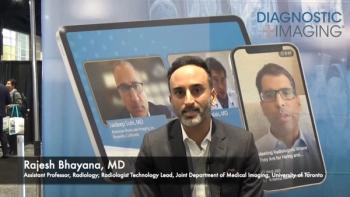Teleradiology Minus the Rads?
Will AI-powered diagnostic workups without on-site docs be a new reality in 2024?
You have probably known folks who take great pains to erase their digital tracks. I am not one of them. I do reasonable things like having antivirus software/firewall and using strong passwords, but I don’t bother with a personal VPN. I don’t fret when my cell, PC, or social media accounts turn out to have been communicating with one another. Really, other than safeguarding my financial stuff or targets for identity theft, I haven’t got anything worth hiding.
Part of that is because I don’t believe anything is ironclad for the long haul. Suppose, for instance, some cutting-edge digital security service comes out tomorrow. Out of the gate, it is verifiably impregnable. Probably sooner than later, I expect that nogoodniks will work hard and find a way to breach it. I see no point in driving myself nuts, eternally trying to stay one step ahead of them.
Another reason is that I rather like it when the Infosphere conspires to show me things that might be relevant to my interests. For instance, Twitter (X if you insist) decided a while ago that my newsfeed should include appearances from other doctorly individuals and health-care related institutions. I would never have sought them all out, but because of my digital footprints, they were showcased nicely for me.
Perhaps it was because of this that my daily news page included an item about a startup offering “CarePods.” They take the aging expression “doc in a box” to a new level. The
Cardiovascular measurements, “biometric body scans,” bloodwork, and even mental health are among the offerings. As you might imagine with new startup innovations that haven’t been fully launched, many details aren’t currently available. At least, the details were not apparent to me after a bit of rooting around online.
Human service providers are not entirely out of the mix. The description includes off-site “medical experts” reviewing patients’ results, and being available to speak while one is still in the CarePod. You might see how a teleradiologist such as myself immediately drew some parallels.
In a number of ways, I consider this a positive development. Innovation, technological advances that improve greater convenience and overall access to services. What’s not to like? Even if this cuts back only a little bit on overwhelmed docs’ offices, clinics, and ERs, it could be a nice pressure relief valve.
There is another thing that appealed to me. The writeup I saw stated that medical insurance, at least to begin with, won’t be directly involved. A customer gets a membership “starting at” $99 a month, which implies that there will be different tiers depending on services rendered, frequency of visits, etc. That dovetails nicely with my support of “Direct Primary Care,” which I have written about. Simply put, health care should be between patients and whoever is treating them. Insurance companies and other third parties can butt out, or maybe reimburse costs for covered services after the fact.
Lest you wonder, I am not swallowing this concept hook, line, and sinker. There are plenty of unknowns (again, typical of startups and new things in general), and without those blanks being filled in I find myself thinking about where other automated services fall flat.
By and large, removing humans from the service industry doesn’t bring improvement. Your mileage may vary, but when I need help with anything other than the most routine of transactions, the absolute last thing I want is to have my phone call answered by a touch-tone menu, or a “support chat” handled by software rather than a person. I almost always wind up wasting time and not achieving my goals.
As if that wasn’t bad enough, some outfits have seen fit to completely remove the option of choosing things like “talk to a human” or “representative” to escape the automation. Others make it effectively impossible by having those options lead to an interminable wait on hold. Sometimes that wait gets peppered with reminders, every 30 to 60 seconds, that “your call is very important to us” or “we appreciate your patience,” which just add insult to time wasting injury.
Optimists might expect that adding artificial intelligence (AI) to the mix will fix this, but I have had the misfortune to encounter automated systems that use them instead of touchtone mazes and, if anything they have made it even more difficult to get anything done. Maybe that will change after AI has gone through a few more stages of evolution, or maybe the AI will just get better at hindering customers whenever satisfaction is at odds with the bottom line.
Getting back to the teleradiology angle, I can’t help but think about all the griping I have heard from non-radiological health-care personnel as remote reading has increased its prevalence. Some of that was envy (“how come you get to work from home in your PJs when I have to dress up and commute?”), but some was based on legitimate concerns about things that get lost in the shuffle when there is less interaction with a flesh-and-blood colleague.
I won’t get into those weeds here but with such concerns, does it make any sense to further remove humans from the equation, especially when said humans would have been the ones to perform physical exams, make eye contact, and generally form a rapport with the patients?
If this does take off, the “medical experts” providing the remote support for the Pods are going to face a learning curve similar to that experienced by rads who moved from onsite to remote work. That’s a not inconsiderable challenge with plenty of pitfalls for those who haven’t been to such a rodeo before. They might do well to retain a telerad consultant or three to ramp up their operations.
Newsletter
Stay at the forefront of radiology with the Diagnostic Imaging newsletter, delivering the latest news, clinical insights, and imaging advancements for today’s radiologists.





























